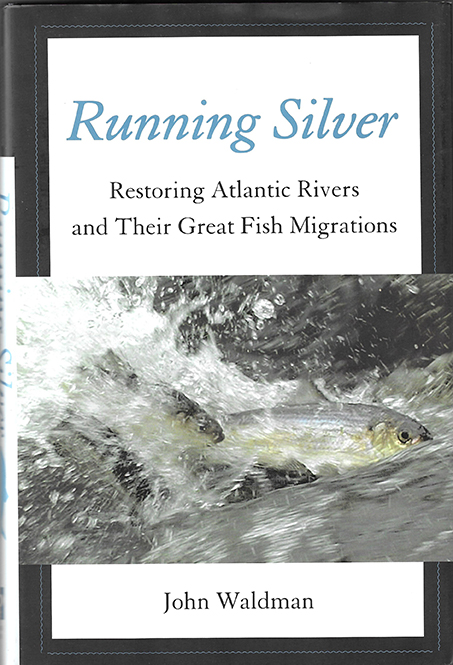Running Silver
Restoring Atlantic Rivers and Their Great Fish Migrations
Book Review by Monica Allard-Cox“How do you unalter a landscape?”
That is the question at the heart of John Waldman’s Running Silver: Restoring Atlantic Rivers and their Great Fish Migrations.
The answer seems to be “usually very badly,” according to Waldman’s research. Published in 2013, Running Silver is not a new book, but it seems appropriate to review given the theme of this issue. And much of what Waldman finds with respect to river restoration remains true today.
He writes that as early as the 1700s, dams were recognized as a problem for anadromous fish, which spend most of their lives in saltwater but return to rivers to spawn. Massachusetts Bay Colony passed a law in 1735 requiring that new dams be built with passages for alewives and other anadromous fish.
It may not surprise you to learn that such laws have rarely been enforced. Even when fish ladders or passages have been built into dams—including recently—they often don’t work. When they do, they frequently leave fish stranded just above the dam, unable to go further or pass the next dam but expending their energy trying.
Even more elaborate efforts to mechanically shove fish upriver in elevators or transport them in trucks have also shown dismal results.
Dam removal is the ideal solution, but as Waldman writes, the logistics can be nearly insurmountable. “People get used to the changed conditions, building homes by the lake created by a dam. Even if people agree that restoration is necessary, they may disagree on what to do. Then there are the policies, laws, and regulations … that have grown up along with the altered landscape that make change difficult to achieve. And even then, once you have come to agreements and satisfied bureaucracies, there is the matter of paying for it all.”
Waldman, a biology, earth, and environmental sciences professor at the City University of New York, writes with an angler’s love of fish. Thus, we learn a great deal about anadromous fishes’ biology, life cycle, and place in history, along with his despair over the conditions they presently face because of human greed.
There are hydropower plants that annually consume billions of fish and fish larvae in their machinery. There are the pressures from overfishing, from the caviar craze that decimated sturgeon populations in the late 19th century—something Waldman describes as “the piscine equivalent of clear-cutting an old-growth forest”— to the 21st-century eel “gold rush” that drew both legal fishers and poachers to Maine for nightly catches worth $30,000 to $40,000 during eel season.
Waldman praises restoration efforts on the Blackstone River, singling out the Blackstone River Watershed Council/Friends of the Blackstone as a model organization. He recognizes John Marsland (see Colleen Cronin’s article in this issue) and colleague Frank Geary for their attitude and aptitude, which have made “the Blackstone restoration one of the most comprehensive in the nation.”
Ironically, the fish passage plan that Waldman cites as imminent for the Blackstone—one that had been shelved since 1980 until the Friends revived it—still has not been realized. The group sought bids in 2012 for the work; the only company that responded came back at nearly double the cost expected.
As Meredith Haas writes in her story on this issue, a coalition of organizations is working to revive the plan and fundraise for its implementation. However, logistics, politics, and activism do not really move Waldman’s writing. The wonders of anadromous fish drive the story.
Waldman marvels at the eels that travel 4,000 miles from the Sargasso Sea to spawn in the land-locked Caspian Sea, the gobies that climb waterfalls higher than 1,000 feet—more than 5,000 times their body length—and even the simple miracle of a shad hatching in an East Coast river, growing in an estuary, entering the Atlantic and surviving a “Murderer’s Row” of predators along its migration, to finding along its route the faint smell of its natal river, calling it home to spawn.
To all these fish, Waldman directs the last words of his book, a quote from Thoreau: “Keep a stiff fin then, and stem all the tides thou mayest meet.”
Narragansett Bay Estuary Program
This issue is supported by the Narragansett Bay Estuary Program (NBEP), a nonprofit organization led by stakeholders that pursues place-based conservation across the three-state Narragansett Bay region.
With its 30-member partnership, NBEP catalyzes scientific inquiry and collective action to restore and protect the region’s water quality, wildlife, and quality of life.
This issue of 41°N highlights several of the stories and partners driving a 10-year blueprint to realize their vision of clean water and habitat to sustain all who live, work, and play in the Narragansett Bay region.
Contact Us
Telephone: (401) 874-6805
Email: allard@uri.edu
Contributor Guidelines
Please review submission guidelines to be considered. d


